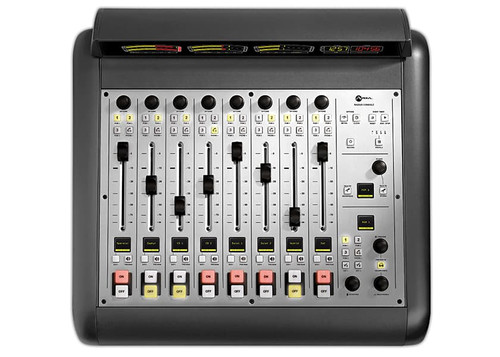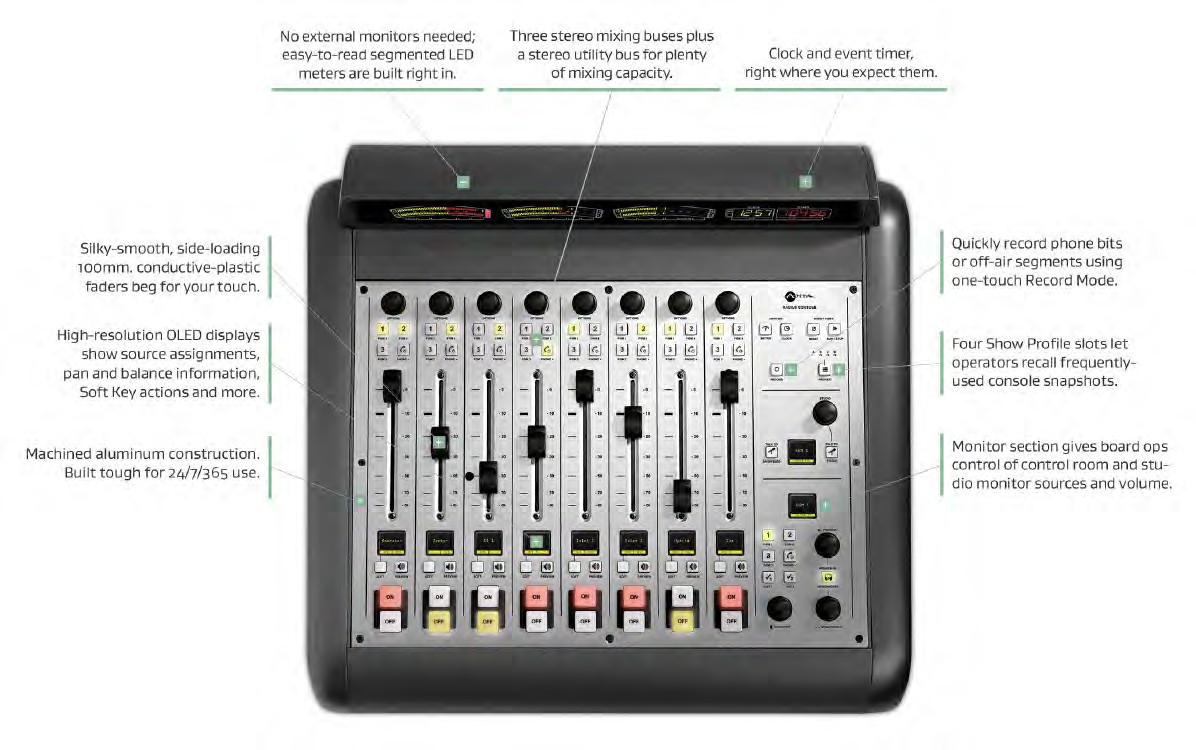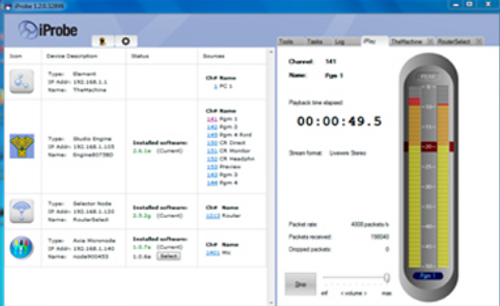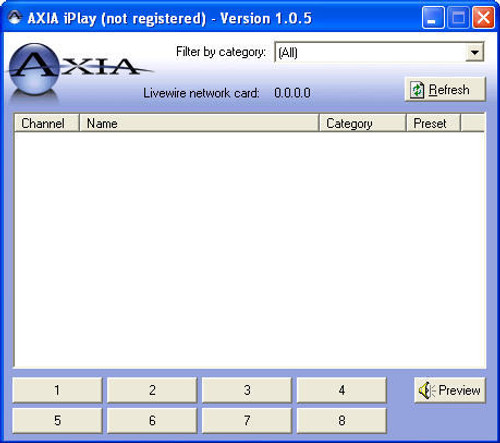QOR.16 Connections (Sold Separately)
-
Microphone Inputs: 2x balanced XLR-F, with selectable Phantom power
-
Analog Inputs: 8x RJ-45, StudioHub+ standard.
-
Analog Outputs: 4x RJ-45, StudioHub+ standard.
-
AES/EBU Inputs: 1x RJ-45, StudioHub+ standard.
-
AES/EBU Outputs: 1x RJ-45, StudioHub+ standard.
-
GPIO: 4x DB-15
- Livewire:
-
4x 100BASE-T with PoE, RJ-45
-
2x 100BASE-T, RJ-45
-
2x 1000BASE-T, RJ-45
-
2x Gigabit, SFP (Small Form Pluggable)
-
-
Console Frame Connections: 1x, 6-pin “latch and lock” style
-
Accessory Connections: 1x, 6-pin “latch and lock” style
Microphone Preamplifiers
-
Source Impedance: 150 Ohms
-
Input Impedance: 4 k Ohms minimum, balanced
-
Nominal Level Range: Adjustable, -75 dBu to -20 dBu
-
Input Headroom: >20 dB above nominal input
-
Output Level: +4 dBu, nominal
Analog Line Inputs
-
Input Impedance: 20 k Ohms
-
Nominal Level Range: Selectable, +4 dBu or -10dBv
-
Input Headroom: 20 dB above nominal input
Analog Line Outputs
-
Output Source Impedance: <50 Ohms balanced
-
Output Load Impedance: 600 Ohms, minimum
-
Nominal Output Level: +4 dBu
-
Maximum Output Level: +24 dBu
Digital Audio Inputs And Outputs
-
Reference Level: +4 dBu (-20 dB FSD)
-
Impedance: 110 Ohm, balanced (XLR)
-
Signal Format: AES-3 (AES/EBU)
-
AES-3 Input Compliance: 24-bit with selectable sample rate conversion, 20 kHz to 216kHz input sample rate capable.
-
AES-3 Output Compliance: 24-bit
-
Digital Reference: Internal (network timebase) or external reference 48 kHz, +/- 2 ppm
-
Internal Sampling Rate: 48 kHz
-
Output Sample Rate: 48 kHz
-
A/D Conversions: 24-bit, Delta-Sigma, 256x oversampling
-
D/A Conversions: 24-bit, Delta-Sigma, 256x oversampling
-
Latency <3 ms, mic in to monitor out, including network and processor loop
Frequency Response
- Any input to any output: +0.5 / -0.5 dB, 20 Hz to 20 kHz
Dynamic Range
-
Analog Input to Analog Output: 102 dB referenced to 0 dBFS, 105 dB “A” weighted to 0 dBFS
-
Analog Input to Digital Output: 105 dB referenced to 0 dBFS
-
Digital Input to Analog Output: 103 dB referenced to 0 dBFS, 106 dB “A” weighted
-
Digital Input to Digital Output: 125 dB
Equivalent Input Noise
- Microphone Preamp: -128 dBu, 150 Ohm source, reference -50 dBu input level
Total Harmonic Distortion + Noise
-
Mic Pre Input to Analog Line Output: <0.005%, 1 kHz, -38 dBu input, +18 dBu output
-
Analog Input to Analog Output: <0.008%, 1 kHz, +18 dBu input, +18 dBu output
-
Digital Input to Digital Output: <0.0003%, 1 kHz, -20 dBFS
-
Digital Input to Analog Output: <0.005%, 1 kHz, -6 dBFS input, +18 dBu output
Crosstalk Isolation, Stereo Separation And CMRR
-
Analog Line channel to channel isolation: 90 dB isolation minimum, 20 Hz to 20 kH
-
Microphone channel to channel isolation: 80 dB isolation minimum, 20 Hz to 20 kHz
-
Analog Line Stereo separation: 85 dB isolation minimum, 20Hz to 20 kHz
-
Analog Line Input CMRR: >50 dB, 20 Hz to 20 kHz
-
Microphone Input CMRR: >50 dB, 20 Hz to 20 kHz
Audio Processing
-
Mic Equalizer (applicable to up to 6 faders)
-
Frequency Bands: 20Hz to 320Hz, 125Hz to 2KHz, 1.25KHz to 20KHz.
-
Cut/Boost range on each band: -25dB to +15dB.
-
Q-factor: Automatic - bandwidth varies based on amount of cut or boost.
Power Supply AC Input, QOR.16 with Radius Console
-
Auto-sensing supply, 100VAC to 240VAC, 50 Hz to 60 Hz, IEC receptacle, internal fuse
-
Power consumption: 100 Watts
Operating Temperatures
- -10 degrees C to +40 degrees C, <90% humidity, no condensation
Dimensions
- 20.5” x 19” x 4.5” (desktop to meter bridge)
Regulatory
North America: FCC and CE tested and compliant, power supply is UL approved.
Europe: Complies with the European Union Directive 2002/95/EC on the restriction of the use of certain hazardous substances in electrical and electronic equipment (RoHS), as amended by Commission Decisions 2005/618/EC, 2005/717/ EC, 2005/747/EC (RoHS Directive), and WEEE.






















